Growing Bacterial Cellulose: Envisioning a Systematic Procedure to Design This Promising Material
Abstract
1. Introduction
2. Literature Review
- What are the best environmental conditions for BC growth (in terms of timing, ingredients, and environmental temperature) to reach a good output quality and reduce defects?
- Once the most appropriate parameters have been chosen, is there a way to standardize and optimize cultivation conditions as much as possible to achieve, without waste and defects, a replicable and stable BC-based material?
3. Methodology: Experimental Procedure Setup and Objectives
- replicate the most popular growth modes;
- identify and understand the most promising strategies; and
- verify the reliability of selected processes.
- ingredients and quantity;
- temperature; and
- jar material and diameter.
- acidity and pH control;
- sugar/honey quantity control;
- temperature;
- growth (thickness) measurement based on time; and
- assessments of different growth mediums.
- aesthetic characteristics of the obtained samples (color, uniformity of surface);
- time taken for growth; and
- thickness obtained.
4. Results
4.1. Growth Monitoring Results
- tea-based solutions (green tea)
- water-based solutions
- powder pigmentation (choosing among affordable and edible coloring powders for coloring samples, and metallic powder to investigate eventual change in physical properties; performed only on green tea basic solution, due to its uniform growth)
- honey as a replacement for sugar as the nutrient (performed only on green tea basic solution, due to its uniform growth).
- water, sugar, and turmeric;
- coconut water and sugar;
- beer;
- coffee and sugar;
- karkadè and sugar;
- green tea and sugar; and
- green tea and honey.
4.2. Results after Drying Phase
4.3. Electronic Microscope Observations
- on the intact edge (surface);
- in the center (surface);
- in the thickness (section) (See Table 3).
4.4. Samples Profiling
5. Discussions and Conclusions
5.1. Alternative Growing Technique
5.2. Alternative Drying Technique
5.3. Future Directions
- Could the same conditions be replicated in semi-automated growth tanks capable of autonomously controlling GM characteristics and fermentation activity in the medium for BC culture?
- Can the amount of medium needed to start BC cultures be predetermined, ensuring that in reaching the desired thickness the entire liquid has been consumed, avoiding wasted resources?
- Are there any alternative drying techniques or natural additives that can temporally stabilize the material and make it biodegradable only when desired?
- identification of the best medium to obtain BC samples that can be deployed in design activities;
- set-up of procedural steps to monitor and control the growth of BC samples at macroscale;
- identification of the best techniques to obtain samples that have similar initial configurations to improve the repeatability of the BC samples growth.
Author Contributions
Funding
Institutional Review Board Statement
Informed Consent Statement
Data Availability Statement
Acknowledgments
Conflicts of Interest
Appendix A
| Name | Ingredients and Quantity | Temp. (°C) | Jar Material and Diameter | Day | pH | Brix (%) | Thickness at Day 25 (mm) |
| SCOBY Turmeric | Water—330 mL Sugar—33 g Vinegar—30 mL SCOBY—45 g Turmeric powder—15 g Starter liquid—75 mL | 35° | PP 98 mm | 1 | 3.35 | 10.2 | 5.00/6.00/6.60 Fairly constant over the surface area |
| 16 | 2.23 | 5.0 | |||||
| 25 | 2.30 | 5.0 | |||||
| SCOBY Coconut | Coconut water—350 mL Sugar—0 g Vinegar—20 mL SCOBY—46 g Starter liquid—75 mL | 35° | Glass 95 mm | 1 | 3.15 | 8.2 | 6.00/7.30/10.80/11.40/12.40 Non-uniform |
| 16 | 2.31 | 3.6 | |||||
| 25 | 2.30 | 3.5 | |||||
| SCOBY Beer | Unfiltered beer—400 mL Sugar—20 g Vinegar—20 mL SCOBY—45 g Starter liquid—75 mL | 35° | PP 98 mm | 1 | 3.10 | 9.0 | 7.80/15.70/16.70 Non-uniform |
| 16 | 2.36 | 5.6 | |||||
| 25 | 2.06 | 5.0 | |||||
| SCOBY Coffee | Coffee—330 mL Sugar—33 g Vinegar—30 mL SCOBY—46 g Starter liquid–75 mL | 35° | PP 98 mm | 1 | 3.19 | 9.8 | 9.20 Uniform on the whole surface |
| 16 | 2.34 | 4.8 | |||||
| 25 | 2.30 | 4.9 | |||||
| SCOBY Karkadè | Karkadè—330 mL Sugar—33 g Vinegar—0 mL SCOBY—48 g Starter liquid—75 mL | 35° | Glass 95 mm | 1 | 2.33 | 9.1 | 2.80/3.20/4.40/4.60/5.40/6.30 Non-uniform |
| 16 | 2.14 | 9.4 | |||||
| 25 | 2.08 | 9.6 | |||||
| SCOBY Green Tea | Green tea—330 mL Sugar—33 g Vinegar—10 mL SCOBY—45 g Starter liquid—75 mL | 35° | Ceramic 90 mm | 1 | 3.00 | 9.4 | 9.90/10.10/11.00/12.30 Fairly non-constant |
| 16 | 2.11 | 7.8 | |||||
| 25 | 2.14 | 8.4 | |||||
| SCOBY Honey | Green tea—330 mL Honey—33 g Vinegar—10 mL SCOBY—60 g Starter liquid—70 mL | 35° | Glass 95 mm | 1 | 3.00 | 7.8 | 5.50/8.50/9.90/11.00 Non-uniform |
| 16 | 2.23 | 6.8 | |||||
| 25 | 2.17 | 6.9 |
Appendix B
| Sample | Top View (Border) | Top View (Center) | Section |
| Water, Sugar, Turmeric |  | ||
| Sample | Top View (Border) | Top View (Center) | Section |
| Coconut water, sugar |  | ||
| Sample | Top View (Border) | Top View (Center) | Section |
| Beer |  | ||
| Sample | Top View (Border) | Top View (Center) | Section |
| Coffee, Sugar |  | ||
| Sample | Top View (Border) | Top View (Center) | Section |
| Green Tea, Sugar |  | ||
| Sample | Top View (Border) | Top View (Center) | Section |
| Green Tea, Honey |  | ||
References
- Volstad, N.L.; Boks, C. On the Use of Biomimicry as a Useful Tool for the Industrial Designer. Sustain. Dev. 2012, 20, 189–199. [Google Scholar] [CrossRef]
- Ceschin, F.; Gaziulusoy, I. Evolution of Design for Sustainability: From Product Design to Design for System Innovations and Transitions. Des. Stud. 2016, 47, 118–163. [Google Scholar] [CrossRef]
- de la Bellacasa, M.P. Matters of Care: Speculative Ethics in More than Human Worlds; University of Minnesota Press: Minneapolis MN, USA, 2017. [Google Scholar]
- Escobar, A. Sustainability: Design for the Pluriverse. Development 2011, 54, 137–140. [Google Scholar] [CrossRef]
- Condell, C.; Lipps, A.; McQuaid, M. Nature: Collaborations in Design; Cooper Hewitt & Cube Design Museum: New York, NY, USA, 2019. [Google Scholar]
- Moreno, A.I.; Font, R.; Conesa, J.A. Physical and Chemical Evaluation of Furniture Waste Briquettes. Waste Manag. 2016, 49, 245–252. [Google Scholar] [CrossRef] [PubMed]
- Dorst, C.H. Design Practice and Design Research: Finally Together? In Design Research Society International Conference; Design Research Society: London, UK, 2016. [Google Scholar] [CrossRef]
- Dorst, K. Design beyond Design. She Ji J. Des. Econ. Innov. 2019, 5, 117–127. [Google Scholar] [CrossRef]
- Rognoli, V.; Parisi, S. Material Tinkering and Creativity. In Materials Designers. Boosting Talent towards Circular Economies; Elisava: Barcelona, Spain, 2021; pp. 20–25. [Google Scholar]
- Fritz, M.; Belcher, A.M.; Radmacher, M.; Walters, D.A.; Hansma, P.K.; Stucky, G.D.; Morse, D.E.; Mann, S. Flat Pearls from Biofabrication of Organized Composites on Inorganic Substrates. Nature 1994, 371, 49–51. [Google Scholar] [CrossRef]
- Camere, S.; Karana, E. Growing materials for product design. In Alive. Active. Adaptive: Proceedings of International Conference on Experiential Knowledge and Emerging Materials (EKSIG 2017), Delft, The Netherlands, 19–20 June 2017; Delft University of Technology: Delft, The Netherlands, 2017; pp. 101–115. [Google Scholar]
- Myers, W.; Antonelli, P. Bio Design: Nature, Science, Creativity; Thames & Hudson: London, UK, 2018. [Google Scholar]
- Gilbert, C.; Tang, T.-C.; Ott, W.; Dorr, B.A.; Shaw, W.M.; Sun, G.L.; Lu, T.K.; Ellis, T. Living Materials with Programmable Functionalities Grown from Engineered Microbial Co-Cultures. Nat. Mater. 2021, 20, 691–700. [Google Scholar] [CrossRef] [PubMed]
- Karana, E.; Nimkulrat, N.; Giaccardi, E.; Niedderer, K.; Fan, J.N. Alive. Active. Adaptive: Experiential Knowledge and Emerging Materials. Int. J. Des. 2019, 13, 1–5. [Google Scholar]
- Materials Come Alive. Nat. Mater. 2022, 21, 379. [CrossRef] [PubMed]
- Karana, E.; Blauwhoff, D.; Hultink, E.-J.; Camere, S. When the material grows: A case study on designing (with) mycelium-based materials. Int. J. Des. 2018, 12, 119–136. [Google Scholar]
- Wijffels, R.H.; Kruse, O.; Hellingwerf, K.J. Potential of Industrial Biotechnology with Cyanobacteria and Eukaryotic Microalgae. Curr. Opin. Biotechnol. 2013, 24, 405–413. [Google Scholar] [CrossRef]
- Lee, S. Grow Your Own Clothes. Available online: https://www.ted.com/talks/suzanne_lee_grow_your_own_clothes (accessed on 30 November 2022).
- Wu, L.; Kim, E. Biofabrication: Using Biological Materials and Biocatalysts to Construct Nanostructured Assemblies. Trends Biotechnol. 2004, 22, 593–599. [Google Scholar] [CrossRef]
- Lehn, J.-M. Toward Self-Organization and Complex Matter. Science 2002, 295, 2400–2403. [Google Scholar] [CrossRef]
- Seeman, N.C.; Belcher, A.M. Emulating Biology: Building Nanostructures from the Bottom Up. Proc. Natl. Acad. Sci. USA 2002, 99 (Suppl. S2), 6451–6455. [Google Scholar] [CrossRef]
- Whitesides, G.M. Self-Assembly at All Scales. Science 2002, 295, 2418–2421. [Google Scholar] [CrossRef]
- United Nations. Make the Sdgs a Reality. Available online: https://sdgs.un.org/ (accessed on 30 November 2022).
- Antonelli, P. Vital Design. In BioDesign. Nature, Science, Creativity; Thames & Hudson: High Holborn, UK, 2012; pp. 6–7. [Google Scholar]
- Miodownik, M.A. Toward Designing New Sensoaesthetic Materials. Pure Appl. Chem. 2007, 79, 1635–1641. [Google Scholar] [CrossRef]
- Ashby, M.; Johnson, K. Materials and Design: The Art and Science of Material Selection in Product Design, 2nd ed.; Elsevier Science: Jordan Hill, UK, 2009. [Google Scholar]
- Sakao, T.; Brambila-Macias, S.A. Do We Share an Understanding of Transdisciplinarity in Environmental Sustainability Research? J. Clean. Prod. 2018, 170, 1399–1403. [Google Scholar] [CrossRef]
- Wilkes, S.; Wongsriruksa, S.; Howes, P.; Gamester, R.; Witchel, H.; Conreen, M.; Laughlin, Z.; Miodownik, M. Design Tools for Interdisciplinary Translation of Material Experiences. Mater. Des. 2016, 90, 1228–1237. [Google Scholar] [CrossRef]
- Rognoli, V.; Bianchini, M.; Maffei, S.; Karana, E. DIY Materials. Mater. Des. 2015, 86, 692–702. [Google Scholar] [CrossRef]
- Camere, S.; Karana, E. Fabricating Materials from Living Organisms: An Emerging Design Practice. J. Clean. Prod. 2018, 186, 570–584. [Google Scholar] [CrossRef]
- Aquary, I.; Kawuri, R.; Ramona, Y.; Cass, G. Optimization of the Production of Microbial Cellulose by Acetobacter xylinum in Aloe barbadensis Mill. Medium. Int. J. Pure Appl. Biosci. 2014, 2, 215–222. [Google Scholar]
- Standoli, C.E.; Casciani, D.; Bolzan, P. Design Interstitial Practices—Le Pratiche Interstiziali Del Design. DIID Disegno Ind. Ind. Des. 2020, 17, 104–111. [Google Scholar]
- Yang, G.H.; Yeo, M.; Koo, Y.W.; Kim, G.H. 4D Bioprinting: Technological Advances in Biofabrication. Macromol. Biosci. 2019, 19, 1800441. [Google Scholar] [CrossRef] [PubMed]
- Lee, S.; Congdon, A.; Parker, G.; Borst, C. Understanding ‘Bio’ Material Innovations. A primer for the Fashion industry. Biofabricate Fash. Good 2020, 8–9, 16–19. [Google Scholar]
- Bolzan, P.; Casciani, D.; Regaglia, A. New perspectives in fashion sustainability through the use of bacterial cellulose. In Proceedings of the DRS2022, Bilbao, Spain, 25 June–3 July 2022; Lockton, D., Lenzi, S., Hekkert, P., Oak, A., Sádaba, J., Lloyd, P., Eds.; pp. 302–324. [Google Scholar] [CrossRef]
- Manzini, M.R. On Italian SI; BRILL eBooks; Brill: Leiden, The Netherlands, 1986; pp. 241–262. [Google Scholar] [CrossRef]
- Ashby, M.F.; Cebon, D. Materials Selection in Mechanical Design. Le J. Phys. IV 1993, 3, C7-1–C7-9. [Google Scholar] [CrossRef]
- Ashby, M.; Johnson, K. The Art of Materials Selection. Mater. Today 2003, 6, 24–35. [Google Scholar] [CrossRef]
- Karana, E.; Barati, B.; Rognoli, V.; van der Laan, A.Z. Material Driven Design (MDD): A Method to Design for Material Experiences. Int. J. Des. 2015, 9, 35–54. [Google Scholar]
- Thomas, S.; Gopi, S.; Amalraj, A. Biopolymers and Their Industrial Applications: From Plant, Animal, and Marine Sources, to Functional Products; Elsevier: Amsterdam, The Netherlands, 2021. [Google Scholar]
- Laavanya, D.; Shirkole, S.; Balasubramanian, P. Current Challenges, Applications and Future Perspectives of SCOBY Cellulose of Kombucha Fermentation. J. Clean. Prod. 2021, 295, 126454. [Google Scholar] [CrossRef]
- Manoukian, O.S.; Sardashti, N.; Stedman, T.; Gailiunas, K.; Ojha, A.; Penalosa, A.; Mancuso, C.; Hobert, M.; Kumbar, S.G. Biomaterials for tissue engineering and regenerative medicine. Encycl. Biomed. Eng. 2019, 462–482. [Google Scholar] [CrossRef]
- Nguyen, H.T.; Saha, N.; Ngwabebhoh, F.A.; Zandraa, O.; Saha, T.; Saha, P. Kombucha-Derived Bacterial Cellulose from Diverse Wastes: A Prudent Leather Alternative. Cellulose 2021, 28, 9335–9353. [Google Scholar] [CrossRef]
- Papile, F.; Bolzan, P.; Parisi, S.; Pollini, B. Perceiving Grown Bacterial Cellulose: An Aesthetic and Sensorial Evaluation of a Bio-Fabricated Material. In UNIDCOM/IADE International Conference Senses & Sensibility; Springer Nature: Cham, Switzerland, 2021; pp. 333–346. [Google Scholar] [CrossRef]
- Ng, F.M.C.; Wang, P.W. Natural Self-Grown Fashion from Bacterial Cellulose: A Paradigm Shift Design Approach in Fashion Creation. Des. J. 2016, 19, 837–855. [Google Scholar] [CrossRef]
- Cleries, L.; Rognoli, V.; Solanki, S.; Llorach, P. Materials Designers: A New Design Discipline. In Materials Designers. Boosting Talent towards Circular Economies; Elisava: Barcelona, Spain; Politecnico di Milano: Milan, Italy, 2020. [Google Scholar]
- Bang, A.L.; Eriksen, M.A. Experiments All the Way in Programmatic Design Research. Artifact 2019, 6, 8.1–8.20. [Google Scholar] [CrossRef]
- Stappers, P.J.; Giaccardi, E. Research through Design. 2012. Available online: https://www.interaction-design.org/literature/book/the-encyclopedia-of-human-computer-interaction-2nd-ed/research-through-design (accessed on 30 November 2022).
- Devanthi, P.V.P.; Kho, K.; Nurdiansyah, R.; Briot, A.; Taherzadeh, M.J.; Aslanzadeh, S. Do Kombucha Symbiotic Cultures of Bacteria and Yeast Affect Bacterial Cellulose Yield in Molasses? J. Fungi 2021, 7, 705. [Google Scholar] [CrossRef] [PubMed]
- Chang, S.T.; Chen, L.C.; Lin, S.B.; Chen, H.H. Nano-biomaterials application: Morphology and physical properties of bacterial cellulose/gelatin composites via crosslinking. Food Hydrocoll. 2012, 27, 137–144. [Google Scholar] [CrossRef]
- Collet, C. Biotextiles: Evolving Textile Design Practices for the Bioeconomy and the Emerging Organism Industry. In Soft Landing; Aalto University School of Arts, Design and Architecture: Helsinki, Finland, 2018; pp. 87–99. [Google Scholar]
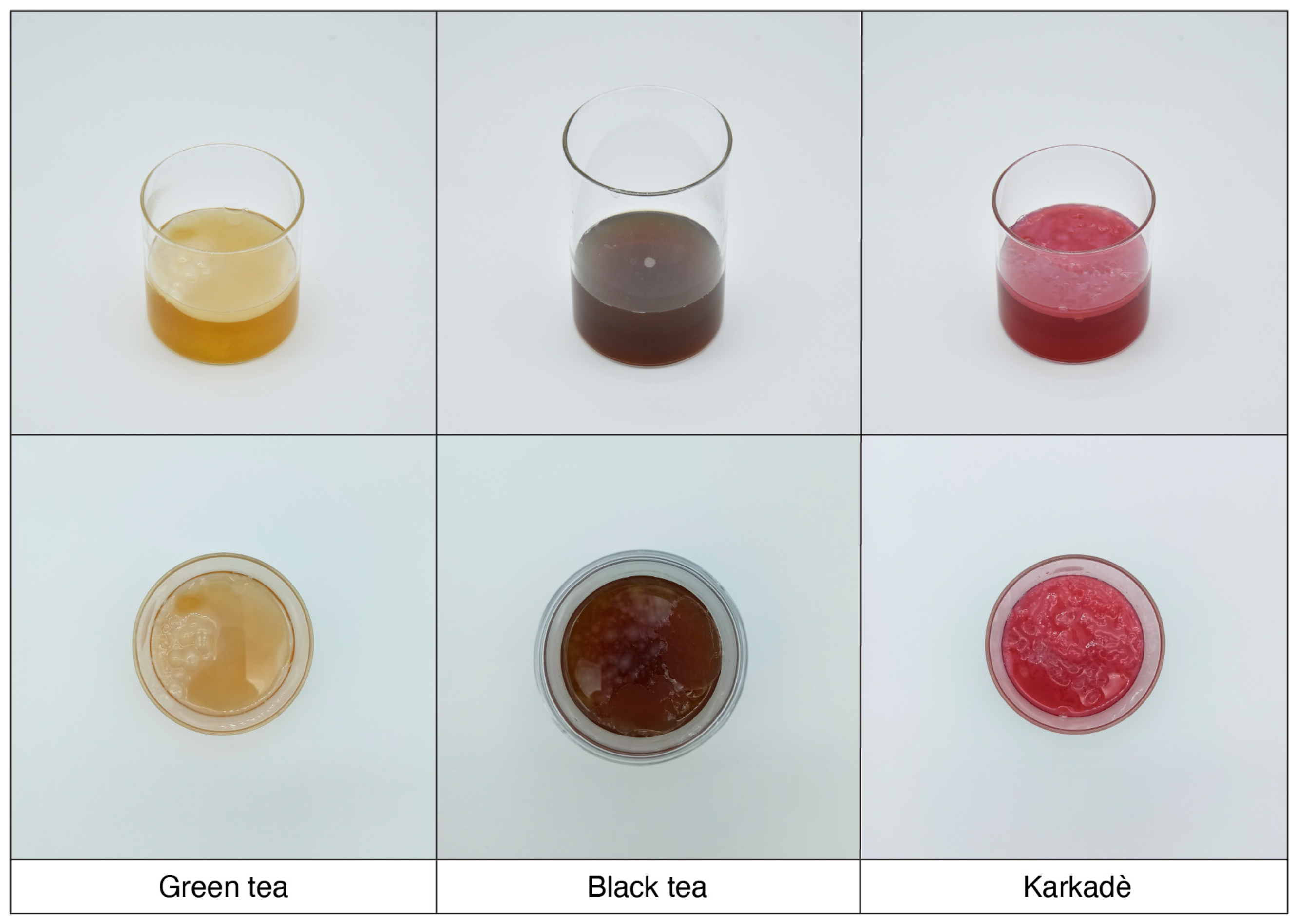
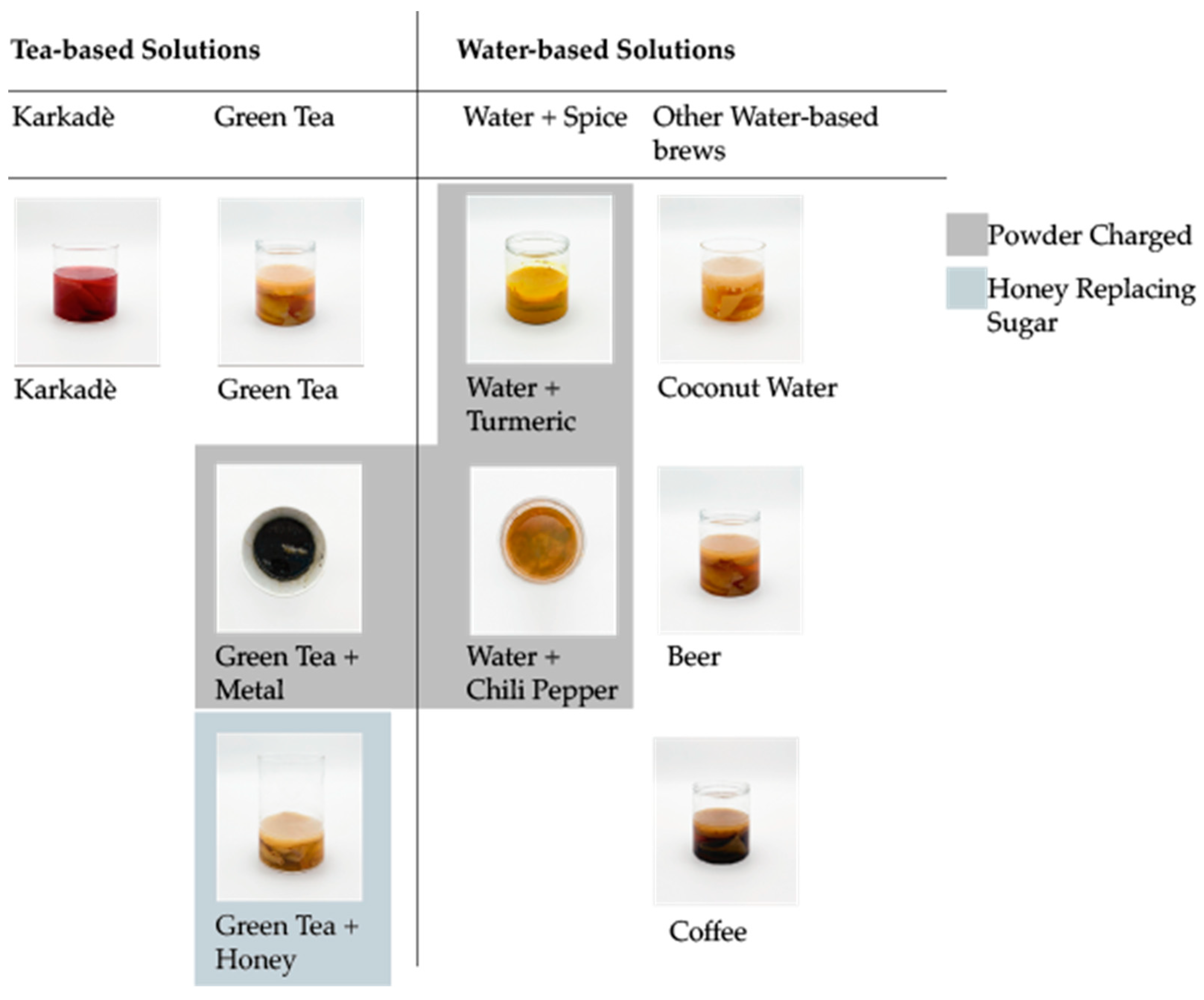
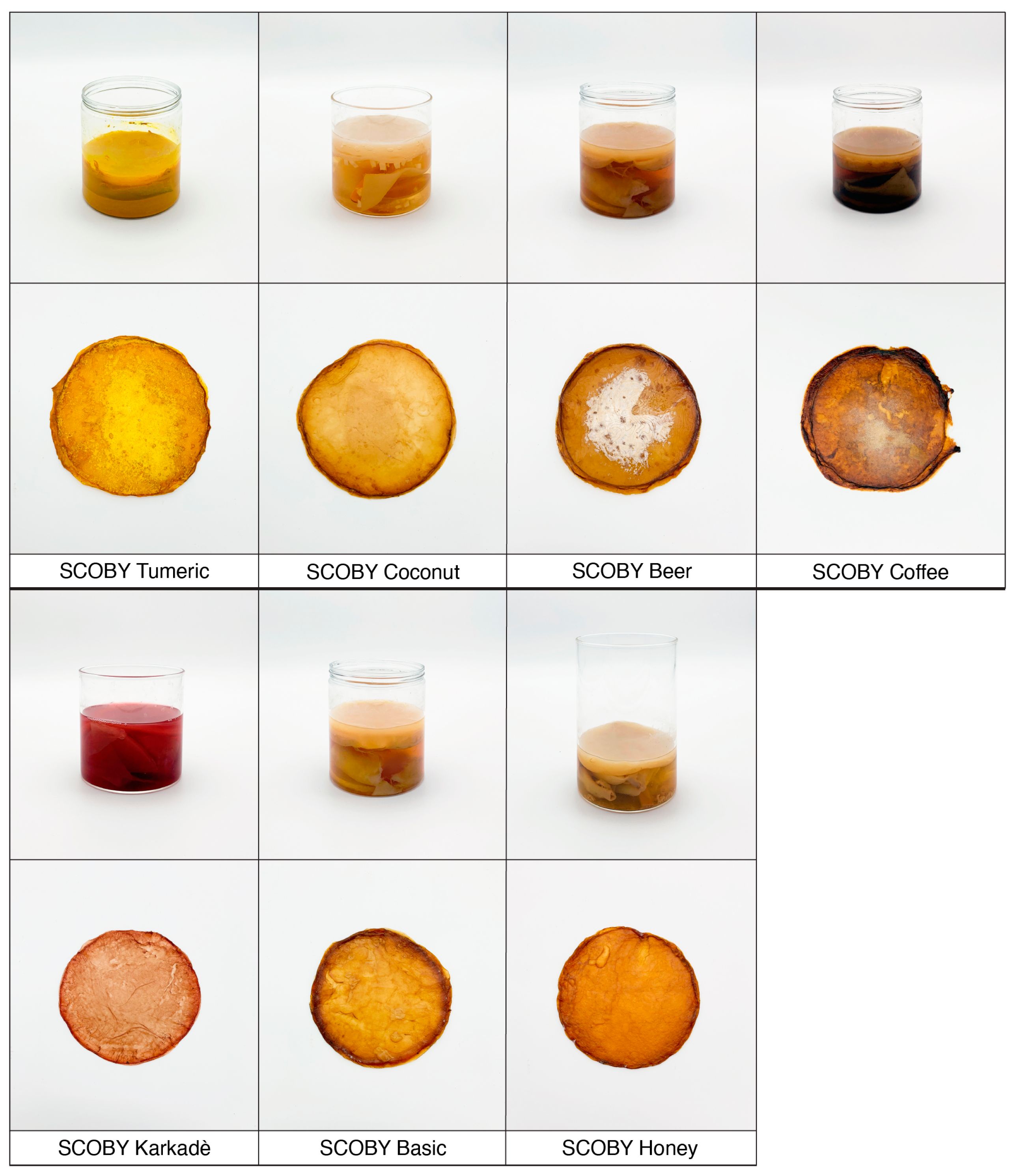




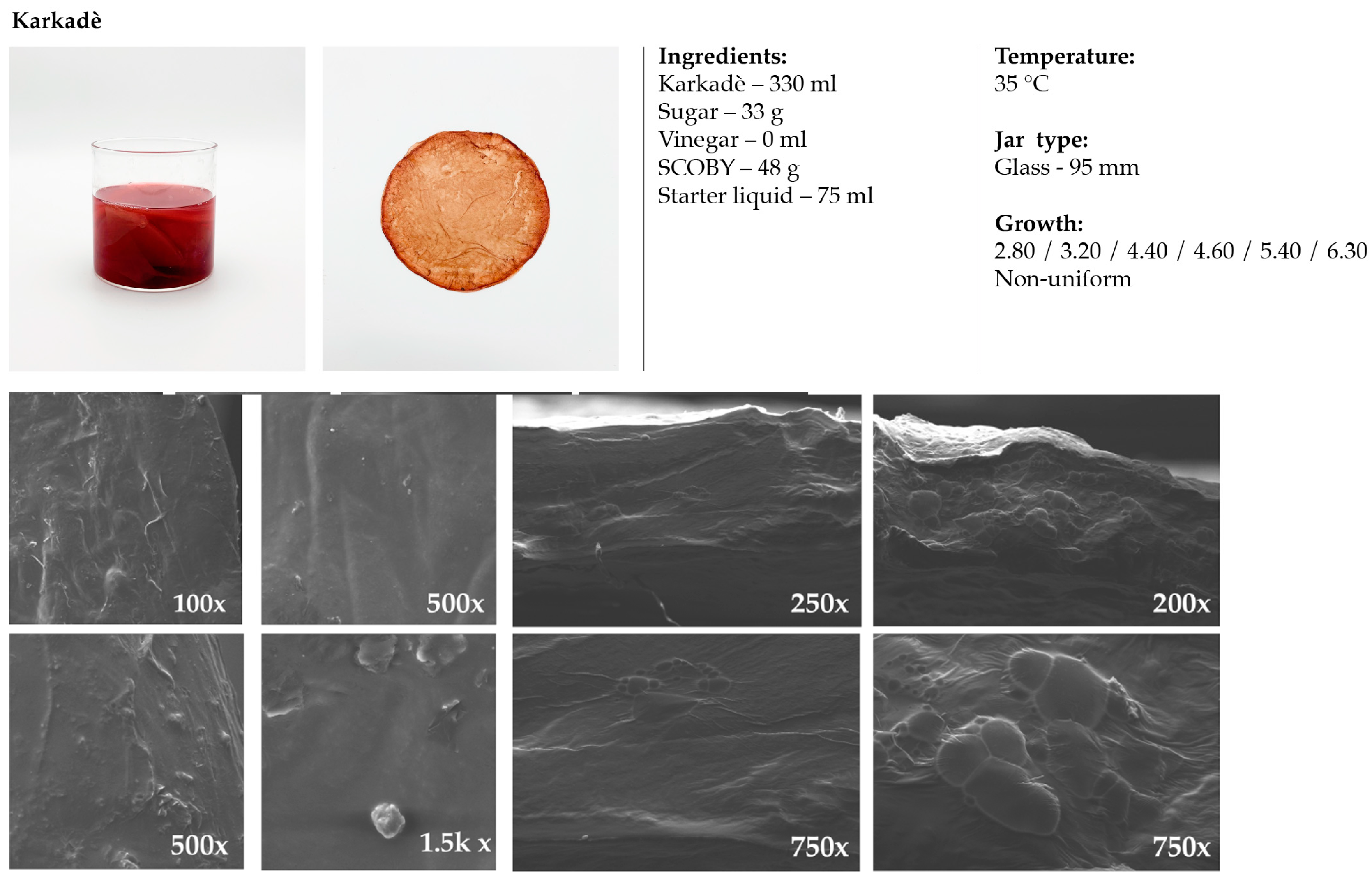


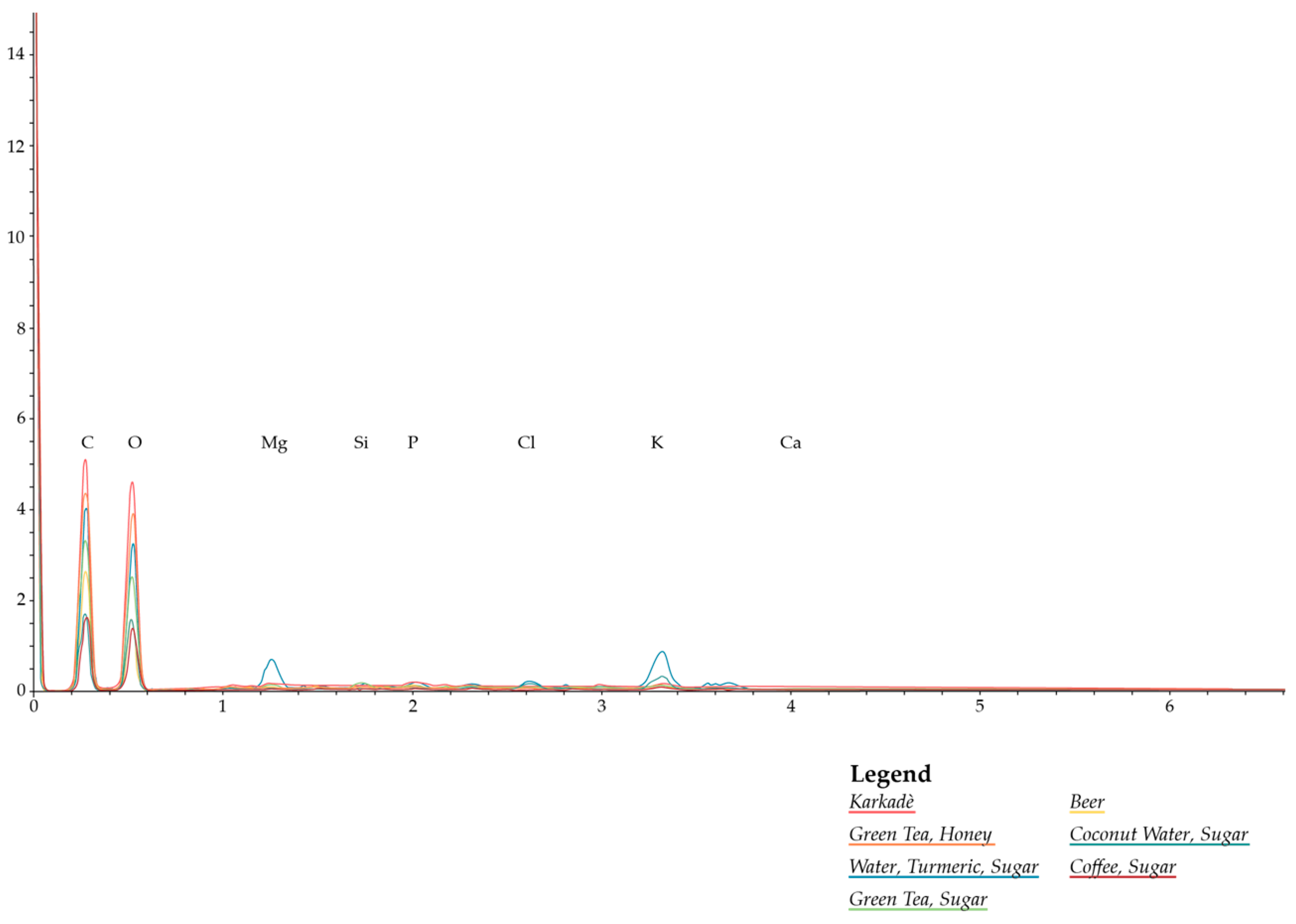
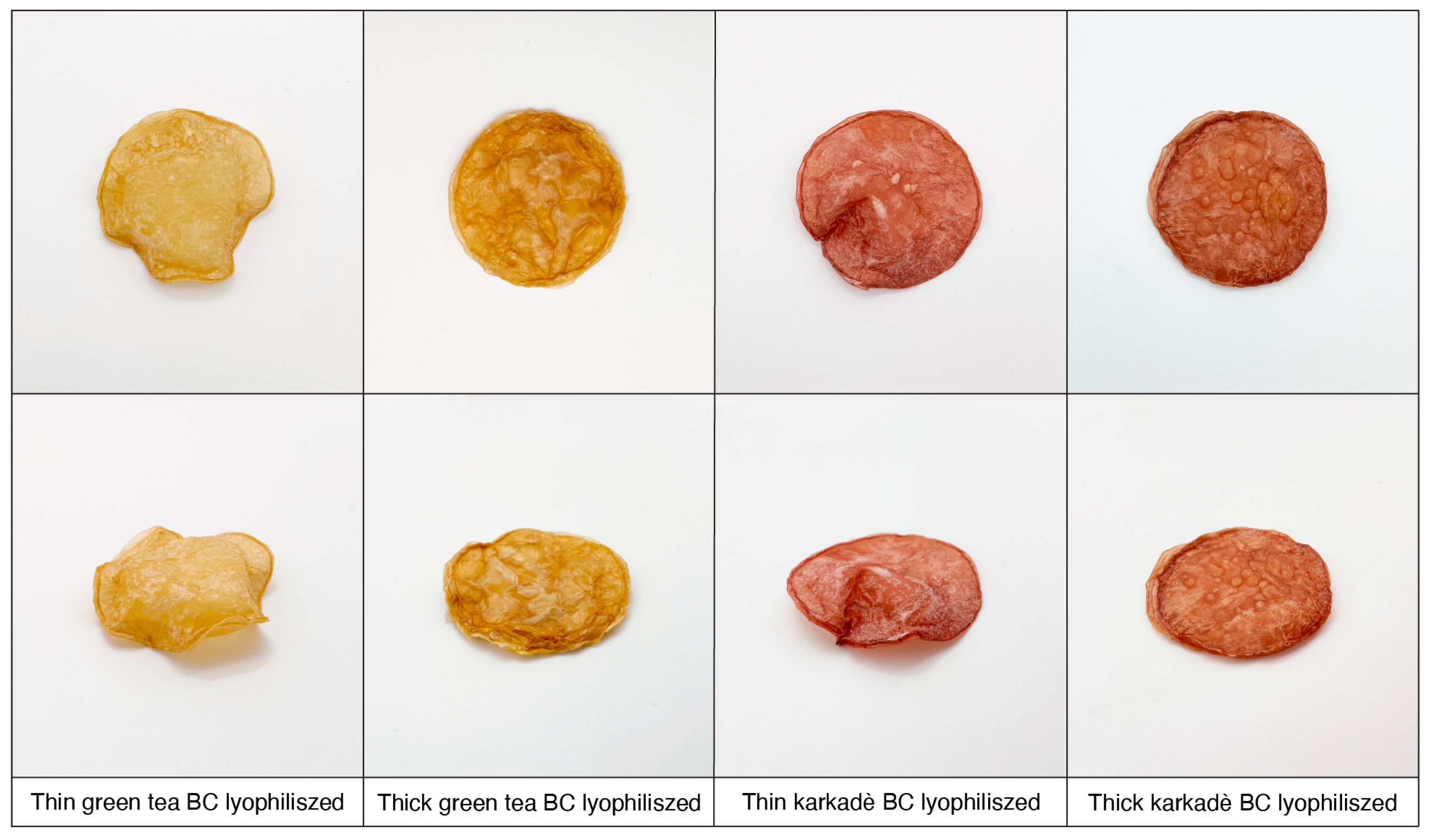
| Name | Ingredients and Quantity | T (°C) | Jar Material and Diameter | Day | pH | Brix (%) | Thickness at Day 25 (mm) |
|---|---|---|---|---|---|---|---|
| SCOBY Green Tea | Green tea—330 mL Sugar—33 g Vinegar—10 mL SCOBY—45 g Starter liquid—75 mL | 35° | Glass 95 mm | 1–25 | 3.00 | 9.4 | 9.90/10.10/ 11.00/12.30 Fairly non-constant |
| SCOBY Black Tea | Black tea—330 mL Sugar—33 g Vinegar—10 mL SCOBY—45 g Starter liquid—75 mL | 35° | Glass 95 mm | 1–25 | 2.27 | 8.2 | 2.20/2.80/3.60 Very thin but almost constant |
| SCOBY Karkadè | Karkadè—330 mL Sugar—33 g Vinegar—0 mL SCOBY—48 g Starter liquid—75 mL | 35° | Glass 95 mm | 1–25 | 2.33 | 9.1 | 2.80/3.20/4.40/4.60/5.40/6.30 Non-uniform |
| Name | Ingredients and Quantity | T °C | Jar Material and Diameter | Day | pH | Brix (%) | Thickness at Day 25 (mm) |
|---|---|---|---|---|---|---|---|
| SCOBY Turmeric | SCOBY—45 g Turmeric powder—15 g Starter liquid—75 mL | 35° | PP 98 mm | 1 | 3.35 | 10.2 | 5.00/6.00/ 6.60 Fairly constant over the surface area |
| 16 | 2.23 | 5.0 | |||||
| 25 | 2.30 | 5.0 |
| Sample | Top View (Border) | Top View (Center) | Section |
|---|---|---|---|
| Water, Sugar, Turmeric |  | ||
Disclaimer/Publisher’s Note: The statements, opinions and data contained in all publications are solely those of the individual author(s) and contributor(s) and not of MDPI and/or the editor(s). MDPI and/or the editor(s) disclaim responsibility for any injury to people or property resulting from any ideas, methods, instructions or products referred to in the content. |
© 2024 by the authors. Licensee MDPI, Basel, Switzerland. This article is an open access article distributed under the terms and conditions of the Creative Commons Attribution (CC BY) license (https://creativecommons.org/licenses/by/4.0/).
Share and Cite
Bolzan, P.; Papile, F. Growing Bacterial Cellulose: Envisioning a Systematic Procedure to Design This Promising Material. Sustainability 2024, 16, 1146. https://doi.org/10.3390/su16031146
Bolzan P, Papile F. Growing Bacterial Cellulose: Envisioning a Systematic Procedure to Design This Promising Material. Sustainability. 2024; 16(3):1146. https://doi.org/10.3390/su16031146
Chicago/Turabian StyleBolzan, Patrizia, and Flavia Papile. 2024. "Growing Bacterial Cellulose: Envisioning a Systematic Procedure to Design This Promising Material" Sustainability 16, no. 3: 1146. https://doi.org/10.3390/su16031146
APA StyleBolzan, P., & Papile, F. (2024). Growing Bacterial Cellulose: Envisioning a Systematic Procedure to Design This Promising Material. Sustainability, 16(3), 1146. https://doi.org/10.3390/su16031146







